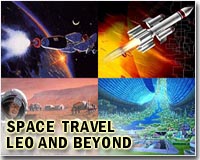 |
AETC Public Affairs Randolph AFB TX (SPX) May 11, 2011 How far can a higher education take you? About 220 nautical miles - straight up. That's at least true for retired Col. Steve Lindsey, an astronaut with NASA and graduate of the Air Force Institute of Technology. Colonel Lindsey's latest space flight, aboard the final mission of the space shuttle Discovery, (STS-133) marked his fifth mission into space - his third as commander - and it all started because of an educational opportunity he earned through AFIT. "In 1987 I was an RF-4 pilot and had an opportunity to apply to the Test Pilot School program," Col. Lindsey said. "Instead of going straight to Test Pilot School, the Air Force selected me for the Joint AFIT/Test Pilot School program. I attended AFIT for five quarters, completing all course work and the analytical portion of my thesis. Then I went directly to Edwards (AFB, Calif.) for test pilot school; while going through that course I also flight tested and then defended my thesis, receiving an MS in Aeronautical Engineering in 1990." The degree he earned, and the academic rigor it instilled in him, is what Col. Lindsey credits for making him one of a very elite few who have experienced life in space. "The AFIT program was instrumental - critical - for preparing me," he said. "Test pilot school is a combination of a lot of flying and academics and engineering. The AFIT experience allowed me to easily handle the academics which gave me an edge and allowed me to concentrate more on the flying. The academic preparation enabled me to do well, which in turn, gave me a better opportunity to compete for the astronaut program." The minimum requirements for astronaut selection as a pilot include graduating from an internationally recognized test pilot school, and having a technical bachelor's level degree, but Col. Lindsey said the reality is that the more advanced degrees one has, the better their prospects. "I believe my AFIT degree and experience got me in the door for the interview," he said. "We work with all kinds of engineering and science experiments in the space program, and that education has carried me through repeatedly and I'm still using it each and every day." So, what's it like more than 200 miles above the Earth? "The first time up it was very cool," Col. Lindsey said. "The thing people remember most is looking at Earth the first time. It's something you never forget - and I wouldn't have been able to witness it if I hadn't gone through AFIT."
Share This Article With Planet Earth
Related Links US Air Force Institute of Technology Space Tourism, Space Transport and Space Exploration News
 US marks 50 years since second human spaceflight
US marks 50 years since second human spaceflightWashington (AFP) May 5, 2011 Three weeks after the world marked 50 years since Russia's Yuri Gagarin became the first man to travel in space, the United States is honoring the American who followed him, Alan Shepard. Shepard was a 37-year-old naval pilot whose trip into space on May 5, 1961 aboard the Mercury 3 spacecraft made him a celebrated American hero. His 15-minute suborbital flight was much shorter than Gaga ... read more |
|
| The content herein, unless otherwise known to be public domain, are Copyright 1995-2010 - SpaceDaily. AFP and UPI Wire Stories are copyright Agence France-Presse and United Press International. ESA Portal Reports are copyright European Space Agency. All NASA sourced material is public domain. Additional copyrights may apply in whole or part to other bona fide parties. Advertising does not imply endorsement,agreement or approval of any opinions, statements or information provided by SpaceDaily on any Web page published or hosted by SpaceDaily. Privacy Statement |